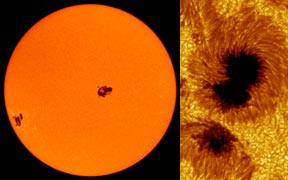Click on image for full size
Courtesy of UCAR
Solar Cycle Variations and Effect on Earth's Climate
For more than 100 years, scientists have wondered if cycles on the Sun and changes of the energy received at Earth because of those cycles affect weather or global climate on Earth. It is now thought that solar cycles on the Sun don't affect weather, but that they do have a very slight effect on global climate.The solar cycle is the rise and fall of the number of sunspots on the Sun. Solar activity is correlated to the number of sunspots on the Sun. As the number of sunspots goes up, solar activity occurrences go up.
Energy output from the Sun also changes as the sunspot count on the Sun changes. It is greatest when there are the most sunspots and lowest when there are the least sunspots. With satellite measurements, scientists have been able to confirm that the total solar energy varies 0.1% over one 11-year sunspot cycle. This variation of 0.1% means a global tropospheric temperature difference of 0.5oC to 1.0oC (1). These facts definitely have to be taken into account when dealing with climate models and predictions.
An example of when the solar cycle affected Earth's climate is the Maunder Minimum. This was when almost no sunspots were seen from about 1645 to 1715. During this time, Europe and parts of North America were struck by spells of really cold weather. This was a change to the expected regional climate.
So there does seem to be a connection between the solar cycle and climate - the very small change in solar energy that changes over the solar cycle seems to have a very small impact on Earth's climate (see IPCC report). Modern climate models take these relationships into account. The changes in solar energy are not big enough, however, to cause the large global temperature changes we've seen in the last 100 years. Indeed, the only way that climate models can match the recent observed warming of the atmosphere is with the addition of greenhouse gases.















